Evaluation of School Building Energy Performance and Classroom Indoor Environment
Abstract
:1. Introduction
2. Materials and Methods
2.1. Analysis of Energy Audits
2.2. School Classroom Thermal and Daylight Evaluation
2.2.1. Thermal Evaluation
- current state: wall with 8 cm of thermal insulation on the interior side;
- renovation scenario I: wall with 15 cm of thermal insulation on the interior side;
- renovation scenario II: wall with 15 cm of thermal insulation on the exterior surface.
- design outdoor temperature −13.0 °C, locality—GPS: 50.655668 N, 14.724856 E;
- design indoor air temperature 21.0 °C (classroom);
- design relative humidity of outdoor air 84.0%;
- design relative humidity of indoor air 55%.
2.2.2. Daylight Evaluation
Daylight Measurements
Daylight Simulations
- light reflectance ρ [-] of the classroom surfaces in current state (resp. designed state): floor finishing 0.35 (resp. 0.5), wall surfaces 0.7 (resp. 0.9), ceiling 0.84 (resp. 0.9).
- window glass light transmittance τ [-]: double glazed units 0.81, triple glazed units 0.73.
- the south-east orientation of the classroom windows (Figure 5).
- CIE clear sky model to simulate sunlight conditions.
- CIE overcast sky model for consideration of the most unfavourable daylight situation.
- Daylight illuminance simulated for the clear sky model on 21st June, at 12:00 was compared with target illuminance 300 lux.
- Daylight factor simulation for the overcast sky model was compared with target daylight factor DT = 2%.
3. Results
3.1. Results of the Energy Audits Analysis
- 23.6% to 57.0% of external walls (U = 0.57 to 1.83 W m−2 K−1).
- 18.3% to 36.0% of roofs (U = 0.36 to 1.50 W m−2 K−1).
- 17.4% to 55.3% of windows (U = 2.30 to 3.50 W m−2 K−1), external doors (U = 3.50 to 6.50 W m−2 K−1).
3.2. Results of the Thermal Evaluation
3.3. Daylight Study Resultss
3.3.1. Measured Data Analysis
3.3.2. Daylight Simulation Outputs
4. Discussion
5. Conclusions
Author Contributions
Funding
Acknowledgments
Conflicts of Interest
References
- Directive (EU) 2018/844 of the European Parliament and of the Council of 30 May 2018. Amending Directive 2010/31/EU on the Energy Performance of Buildings and Directive 2012/27/EU on Energy Efficiency. Available online: https://eur-lex.europa.eu/legal-content/EN/TXT/?toc=OJ%3AL%3A2018%3A156%3ATOC&uri=uriserv%3AOJ.L_.2018.156.01.0075.01.ENG (accessed on 15 January 2020).
- Energy Transition of the EU Building Stock. Available online: https://www.openexp.eu/sites/default/files/publication/files/Reports/energy_transition_of_the_eu_building_stock_full_report.pdf (accessed on 15 January 2020).
- Pérez-Lombard, L.; Ortiz, J.; Pout, C. A review on buildings energy consumption information. Energy Build. 2008, 40, 394–398. [Google Scholar] [CrossRef]
- Butala, V.; Novak, P. Energy consumption and potential energy savings in old school buildings. Energy Build. 1999, 29, 241–246. [Google Scholar] [CrossRef]
- Mahdavi, A.; Doppelbauer, E. A performance comparison of passive and low-energy buildings. Energy Build. 2010, 42, 1314–1319. [Google Scholar] [CrossRef]
- Mihai, M.; Tanasiev, V.; Dinca, C.; Badea, A.; Vidu, R. Passive house analysis in terms of energy performance. Energy Build. 2017, 144, 74–86. [Google Scholar] [CrossRef]
- Gohardani, N.; Björk, F. Sustainable refurbishment in building technology. Smart Sustain. Built Environ. 2012, 1, 241–252. [Google Scholar] [CrossRef]
- Leung, B.C.-M. Greening existing buildings [GEB] strategies. Energy Rep. 2018, 4, 159–206. [Google Scholar] [CrossRef]
- Zimmermann, M. School Building Renovation for Sustainable Second Life, in IEA ECBCS Annex 50 Prefabricated Systems for Low Energy Renovation of Residential Buildings. Building Renovation Case Studies, Empa, Duebendorf. 2011. Available online: https://annex53.iea-ebc.org/Data/publications/EBC_Annex_50_Documented_CaseStudies.pdf (accessed on 14 January 2020).
- Erhorn-Kluttig, H.; Mørck, O. Energy-Efficient Renovation of Educational Buildings, PEB Exchange, Programme on Educational Building 2005/9. OECD Publishing. Available online: https://ideas.repec.org/p/oec/eduaaa/2005-9-en.html (accessed on 17 January 2020).
- Burman, B.; Kimpian, J.; Mumovic, J. Building Schools for the Future: Lessons Learned from Performance Evaluations of Five Secondary Schools and Academies in England. Front. Built Environ. 2018. Available online: https://www.frontiersin.org/articles/10.3389/fbuil.2018.00022/full (accessed on 17 January 2020).
- Advanced Energy Design Guide for K-12 School Buildings. Achieving 50% Energy Savings toward a Net Zero Energy Building. American Society of Heating, Refrigerating and Air-Conditioning Engineers. 2011. Available online: file:///D:/Downloads/Energy_Design_Guide_for_Schools_k_12_LEE.pdf (accessed on 14 January 2020).
- Schools. Carbon Trust. 2012. Available online: https://www.carbontrust.com/media/39232/ctv019_schools.pdf (accessed on 14 January 2020).
- School of the Future. Towards Zero Emission with High Performance Indoor Environment. EU 7th Framework Programme—EeB-ENERGY, Project Number: 260102. The Project Final Report. Available online: http://www.ectp.org/fileadmin/user_upload/documents/E2B/School_of_the_future/1_School_of_the_Future_Final_public_report.pdf (accessed on 7 May 2020).
- Raatikainen, M.; Skön, J.; Leiviskă, K.; Kolehmainen, M. Intelligent analysis of energy consumption in school buildings. Appl. Energy 2016, 165, 416–429. [Google Scholar] [CrossRef]
- Erhorn, H.; Mroz, T.; Mørck, O.; Schmidt, F.; Schoff, L.; Thomsen, K.L. The Energy Concept Adviser—A tool to improve energy efficiency in educational buildings. Energy Build. 2008, 40, 419–428. [Google Scholar] [CrossRef]
- Hong, S.; Paterson, G.; Mumovic, D.; Steadman, P. Improved benchmarking comparability for energy consumption in schools. Build. Res. Inf. 2014, 42, 47–61. [Google Scholar] [CrossRef]
- Agdas, D.; Srinivasan, R.S.; Frost, K.; Masters, K.J. Energy use assessment of educational buildings: Toward a campus-wide sustainable energy policy. Sustain. Cities Soc. 2015, 17, 15–21. [Google Scholar] [CrossRef] [Green Version]
- Najjar, M.K. Integrating parametric analysis with building information modelling to improve energy performance of construction projects. Energies 2019, 12, 1515. [Google Scholar] [CrossRef] [Green Version]
- Becker, R.; Goldberger, I.; Paciuk, M. Improving energy performance of school buildings while ensuring indoor air quality ventilation. Build. Environ. 2007, 42, 3261–3276. [Google Scholar] [CrossRef]
- Ascione, F.; Bianco, N.; De Masi, R.F.; Mauro, G.M.; Vanoli, G.P. Energy retrofit of educational buildings: Transient energy simulations, model calibration and multi-objective optimization towards nearly zero-energy performance. Energy Build. 2017, 144, 303–319. [Google Scholar] [CrossRef]
- Zomorodian, Z.S.; Tahsildoost, M.; Hafezi, M. Thermal comfort in educational buildings: A review article. Renew. Sustain. Energy Rev. 2016, 59, 895–906. [Google Scholar] [CrossRef]
- Barbhuiya, S.; Barbhuiya, S. Thermal comfort and energy consumption in a UK educational building. Build. Environ. 2013, 68, 1–11. [Google Scholar] [CrossRef]
- Wang, Y.; Kuckelkorn, J.; Zhao, F.; Liu, D.; Kirschbauma, A.; Zhange, J. Evaluation on classroom thermal comfort and energy performance of passive school building by optimizing HVAC control systems. Build. Environ. 2015, 89, 86–106. [Google Scholar] [CrossRef]
- Chatzidiakou, E.; Mumovic, D.; Summerfield, A.J.; Altamirano, H.M. Indoor air quality in London schools. Part 1: Performance in use. Intelligent Buildings International, Taylor & Francis, Special Issue: Designing Intelligent School Buildings: What do We Know. Intell. Bulid. Int. 2015, 7, 101–129. Available online: http://www.tandfonline.com/doi/abs/10.1080/17508975.2014.918870#.VSlx-txfWHg (accessed on 12 May 2020).
- Manfren, M.; Nastasi, B.; Piana, E.; Tronchin, L. On the link between energy performance of building and thermal comfort: An example. AIP Conf. Proc. 2019, 2123, 020066. [Google Scholar] [CrossRef]
- Gelfand, L.; Freed, E.C. Sustainable School Architecture: Design for Elementary and Secondary Schools; John Wiley & Sons: Hoboken, NJ, USA, 2010. [Google Scholar]
- Gonzalo, R.; Habermann, K.J. Energy-Efficient Architecture: Basics for Planning and Construction; Birkhäuser: Basel, Switzerland, 2002. [Google Scholar]
- Jaffe, S.B.; Fleming, R.; Karlen, M.; Roberts, S.H. Sustainable Design Basics; John Willey and Sons: Hoboken, NJ, USA, 2020. [Google Scholar]
- Dubey, K.; Dodonov, A. Mapping of Existing Technologies to Enhance Energy Efficiency in Buildings in the UNECE Region, Joint Task Force on Energy Efficiency Standards in Buildings; United Nations Economic Commission for Europe: Geneva, Switzerland, 2018; Available online: https://www.unece.org/fileadmin/DAM/hlm/Meetings/2018/10_03_Geneva/1_Study_on_Mapping_of_EE_technologies_v2.pdf (accessed on 29 April 2020).
- Windows—Making It Clear: Energy, Daylight and Thermal Comfort (NF78). National House Building Council (NHBC) Foundation, 2017. Available online: https://www.buildup.eu/en/practices/publications/windows-making-it-clear-energy-daylight-and-thermal-comfort-nf78-0 (accessed on 29 April 2020).
- Persson, M.L.; Roos, A.; Wall, M. Influence of window size on the energy balance of low energy houses. Energy Build. 2006, 38, 181–188. [Google Scholar] [CrossRef]
- Ochoa, C.E.; Aries, M.B.C.; Loenen, E.J.; Hensen, J.L.M. Considerations on design optimization criteria for windows providing low energy consumption and high visual comfort. Appl. Energy 2012, 95, 238–245. [Google Scholar] [CrossRef] [Green Version]
- Wierzbicka, A.; Pedersen, E.; Persson, R.; Nordquist, B.; Stålne, K.; Gao, C.; Harderup, L.E.; Borell, J.; Caltenco, H.; Ness, B.; et al. Healthy indoor environments: The need for a holistic approach. Int. J. Environ. Res. Public Health 2018, 15, 1874. [Google Scholar] [CrossRef] [PubMed] [Green Version]
- Wang, Y.; Du, J.; Kuckelhorn, J.M.; Kirschbaum, A.; Gu, X.; Li, D. Identifying the feasibility of establishing a passive house school in central Europe: An energy performance and carbon emissions monitoring study in Germany. Renew. Sustain. Energy Rev. 2019, 113, 109256. [Google Scholar] [CrossRef]
- Energy Audits of School Buildings, Archive of the State Environmental Fund of the Czech Republic, Prague. Available online: https://www.sfzp.cz/en/ (accessed on 21 April 2020).
- Primary School Mirova, Mimon, 2015, Mimon. Available online: http://zsamsmirova.cz/ (accessed on 16 January 2020).
- Svoboda, Z. Thermal Assessment Software, CVUT Prague. Available online: http://kcad.cz/cz/stavebni-fyzika/tepelna-technika/ (accessed on 12 January 2020).
- ISO 6946:2017 Building Components and Building Elements—Thermal Resistance and Thermal Transmittance—Calculation Methods; ISO: Geneva, Switzerland, 2017.
- ISO 13788:2012 Hygrothermal Performance of Building Components and Building Elements—Internal Surface Temperature to Avoid Critical Surface Humidity and Interstitial Condensation—Calculation Methods; ISO: Geneva, Switzerland, 2012.
- ČSN 730540 Thermal Protection of Buildings (Tepelná Ochrana Budov). Available online: https://www.buildup.eu/en/practices/publications/czech-republic-standard-csn-73-0540-thermal-protection-buildings (accessed on 12 May 2020).
- ISO 10211:2017 Thermal Bridges in Building Construction—Heat Flows and Surface Temperatures—Detailed Calculations; ISO: Geneva, Switzerland, 2017.
- Šála, J. Interpretation of Provisions of the Czech Standard ČSN 73 0540 Thermal Protection of Buildings for Residential Wooden Houses and Design Recommended Practice. Prague, CZ. 2007. Available online: https://www.competitionline.com/upload/downloads/16xx/1673_3028045_Interpretation_of_thermal_standards.pdf (accessed on 29 April 2020).
- Shishegar, N.; Boubekri, M. Natural light and productivity: Analyzing the impacts of daylighting on students’ and workers’ health and allertness. Int. J. Adv. Chem. Eng. Biol. Sci. 2016, 3, 72–77. Available online: https://iicbe.org/upload/4635AE0416104.pdf (accessed on 12 May 2020).
- Wu, W.; Ng, E. A review of the development of daylighting in schools. Light. Res. Technol. 2003, 35, 111–125. [Google Scholar] [CrossRef] [Green Version]
- Nocera, F.; Faro, A.L.; Constanzo, V.; Raciti, C. Daylight Performance of Classrooms in a Mediterranean School Heritage Building. Sustainability 2018, 10, 3705. [Google Scholar] [CrossRef] [Green Version]
- Küller, R.; Ballal, S.; Laike, T.; Mikellides, B.; Tonello, G. The impact of light and colour on psychological mood: A cross-cultural study of indoor work environments. Ergon. Des. 2006, 49, 1496–1507. [Google Scholar] [CrossRef]
- Küller, R.; Lindsten, C. Health and behaviour of children in classrooms with and without windows. J. Environ. Psychol. 1992, 12, 305–317. [Google Scholar] [CrossRef]
- Pellegrino, A.; Cammarano, S.; Savio, V. Daylighting for Green schools: A resource for indoor quality and energy efficiency in educational environments. Energy Procedia 2015, 78, 3162–3167. [Google Scholar] [CrossRef] [Green Version]
- Maesano, C.; Annesi-Maesano, I. Impact of lighting on school performance in European classrooms. In Proceedings of the CLIMA 2013—the 12th REHVA World Congress, Aalborg, Denmark, 22–25 May 2016; pp. 1–14. [Google Scholar]
- Costanzo, V.; Evola, G.; Marletta, L. A review of daylighting strategies in schools: State of the art and expected future trends. Buildings 2017, 7, 41. [Google Scholar] [CrossRef] [Green Version]
- Heschong, L.; Wright, R.L.; Okura, S. Daylighting impacts on human performance in school. J. Illum. Eng. Soc. 2013, 31, 101–114. [Google Scholar] [CrossRef]
- Renew School. Available online: https://www.renew-school.eu/en/about/ (accessed on 15 January 2020).
- Energy Efficiency. IEA, 2018. Available online: https://www.iea.org/efficiency2018/ (accessed on 16 January 2020).
- Guzowski, M. Daylighting for Sustainable Design; McGraw-Hill: Hoboken, NJ, USA, 2000. [Google Scholar]
- Houck, F. A novel approach on assessing daylight access in schools. Procedia Econ. Financ. 2015, 21, 40–47. [Google Scholar] [CrossRef]
- Piderit, M.B.; Labarca, C.Y. Methodology for assessing daylighting design strategies in classroom with a climate-based method. Sustainability 2015, 7, 880–897. [Google Scholar] [CrossRef] [Green Version]
- Bellia, L.; Pedace, A.; Barbato, G. Lighting in educational environments: An example of a complete analysis of the effects of daylight and electric light on occupants. Build. Environ. 2013, 68, 50–65. [Google Scholar] [CrossRef]
- Zomorodian, Z.S.; Korsavi, S.S.; Tahsildoost, M. The effect of window configuration on daylight performance in classrooms: A field and simulation study. Int. J. Arch. Urban Plan. 2016, 26, 15–24. Available online: https://www.researchgate.net/publication/305026369_The_effect_of_window_configuration_on_daylight_performance_in_classrooms_A_field_and_simulation_study#fullTextFileContent (accessed on 12 May 2020).
- IESNA Lighting Handbook. Illuminating Engineering Society of North America, 9th ed.; IESNA: New York, NY, USA, 2000. [Google Scholar]
- BS EN 17037:2018 Daylight in Buildings; BSI: London, UK, 2018.
- EN 12464-1. Light and Lighting—Lighting of Work Places—Part 1: Indoor Work Places; CEN (European Committee for Standardization: Brussels, Belgium, 2011. [Google Scholar]
- Statistica Software. Available online: http://www.statsoft.com/Products/STATISTICA-Features (accessed on 10 October 2019).
- Daylight Visualizer, Velux. Available online: https://www.velux.com/article/2016/daylight-visualizer (accessed on 10 October 2019).
- ISO 15469:2004 Spatial Distribution of Daylight—CIE Standard General Sky; ISO: Geneva, Switzerland, 2004.
- Mandalaki, M.; Tsoutsos, T. Solar Shading Systems: Design, Performance and Integrated Photovoltaics; Springer Briefs in Energy; Springer: Berlin, Germany, 2019. [Google Scholar] [CrossRef]
- Scartezzini, J.-L.; Courret, G. Anidolic daylighting systems. Sol. Energy 2002, 73, 123–135. [Google Scholar] [CrossRef]

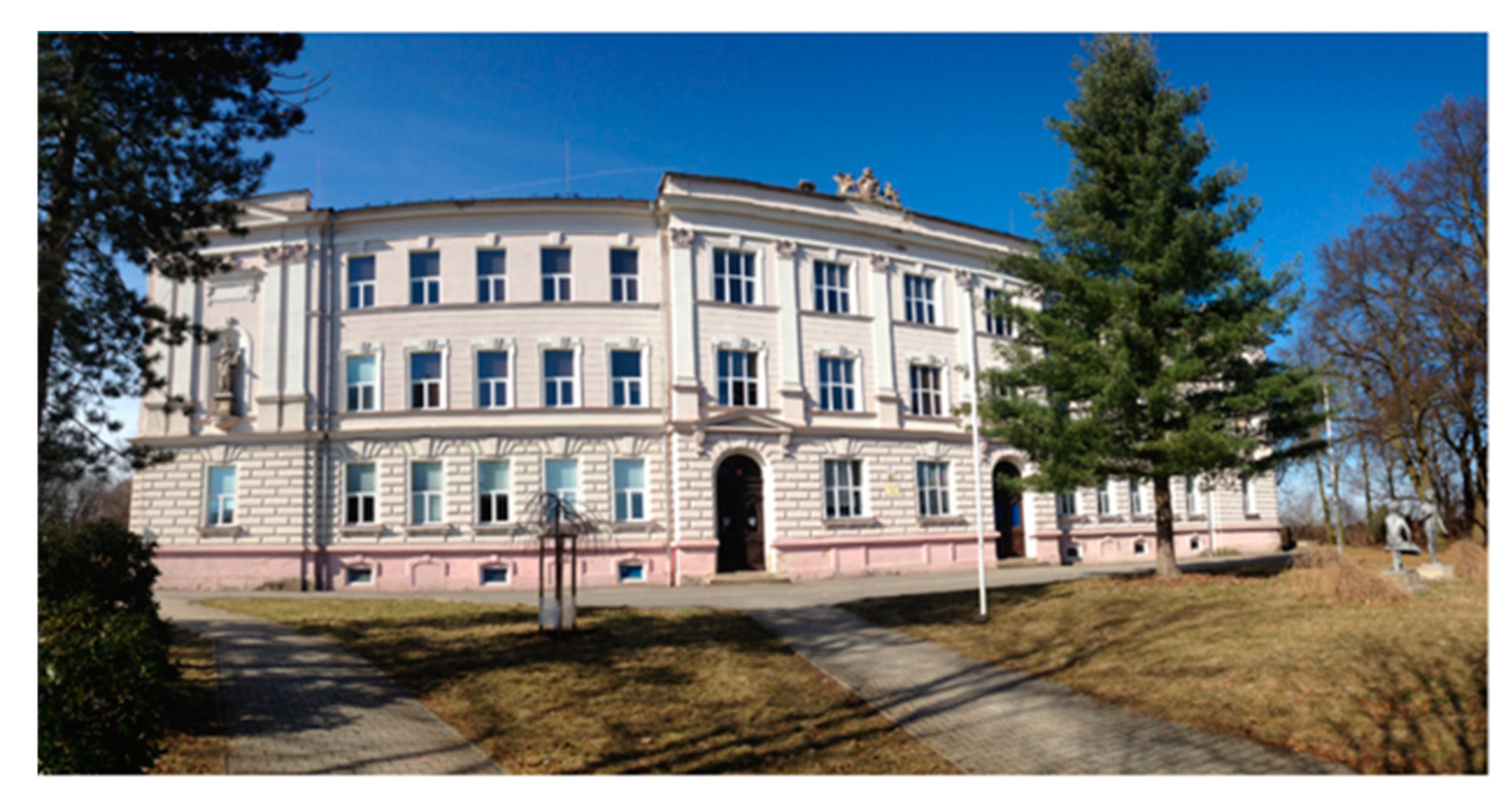
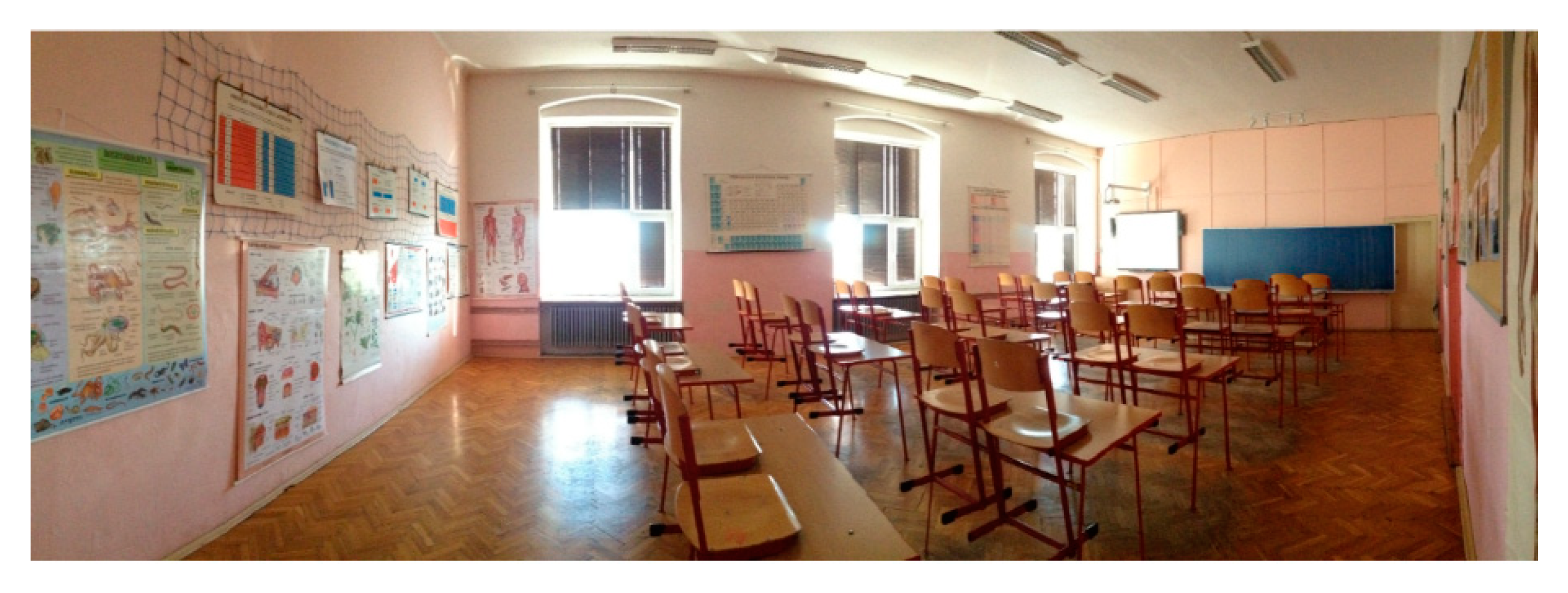
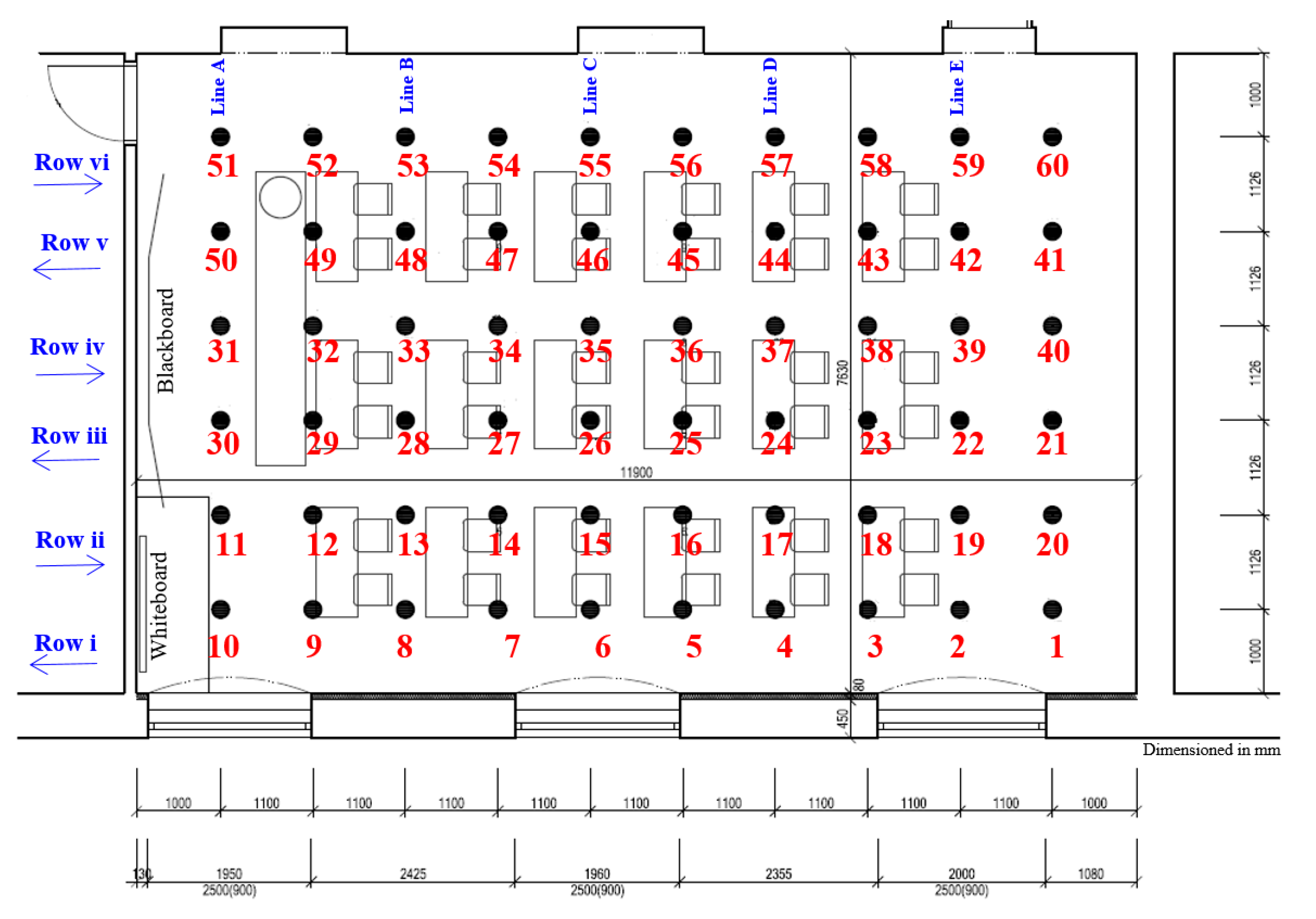

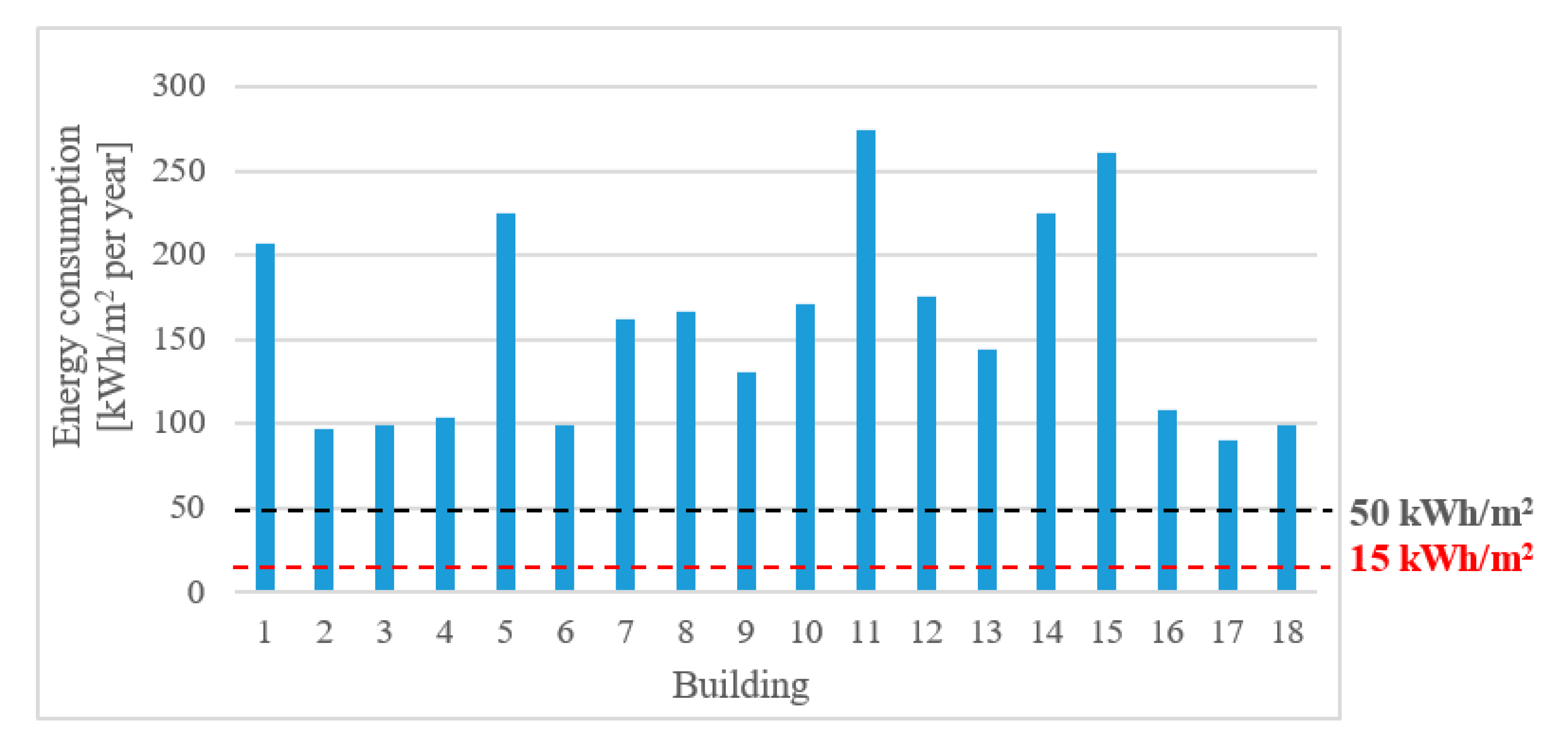

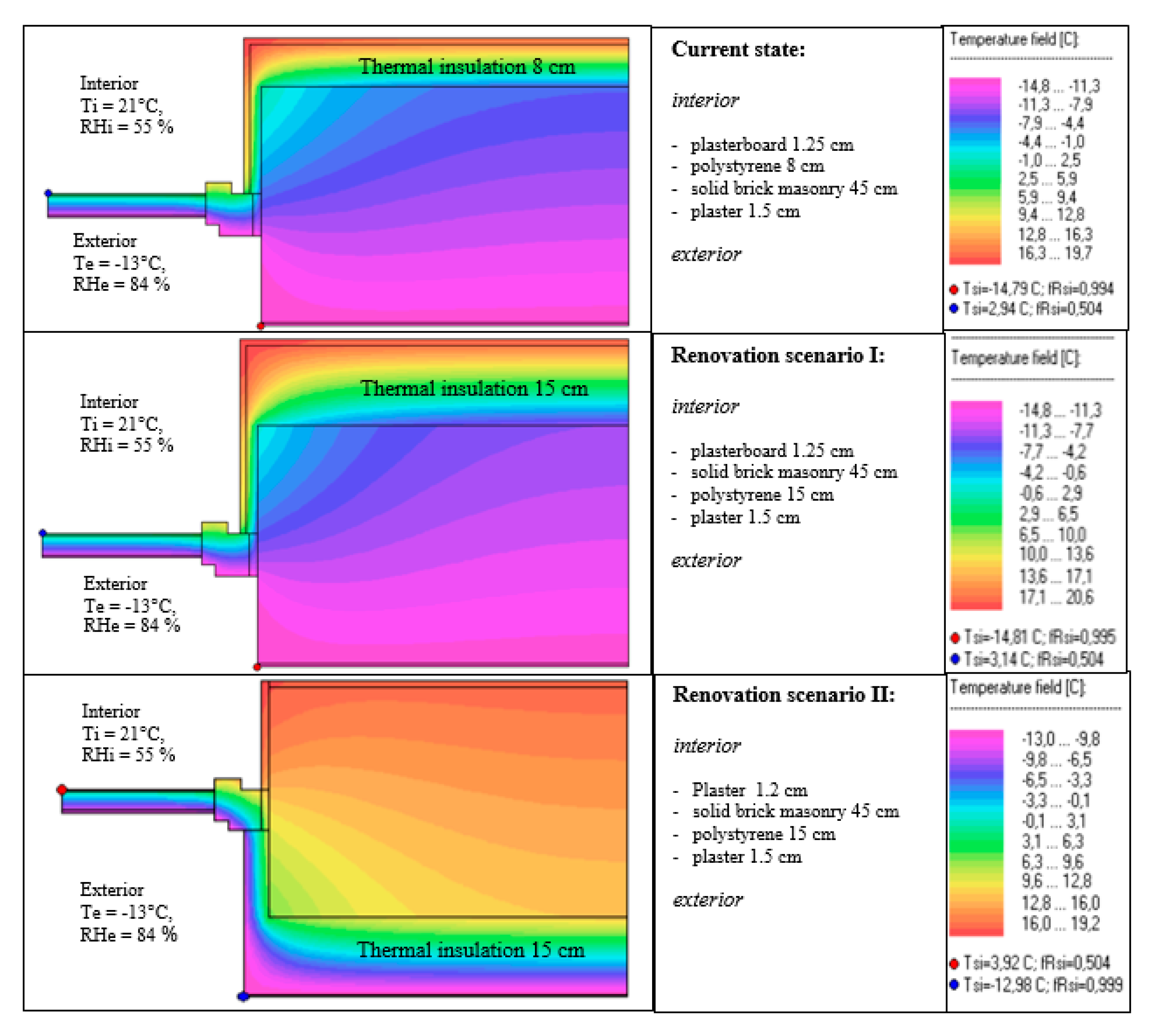
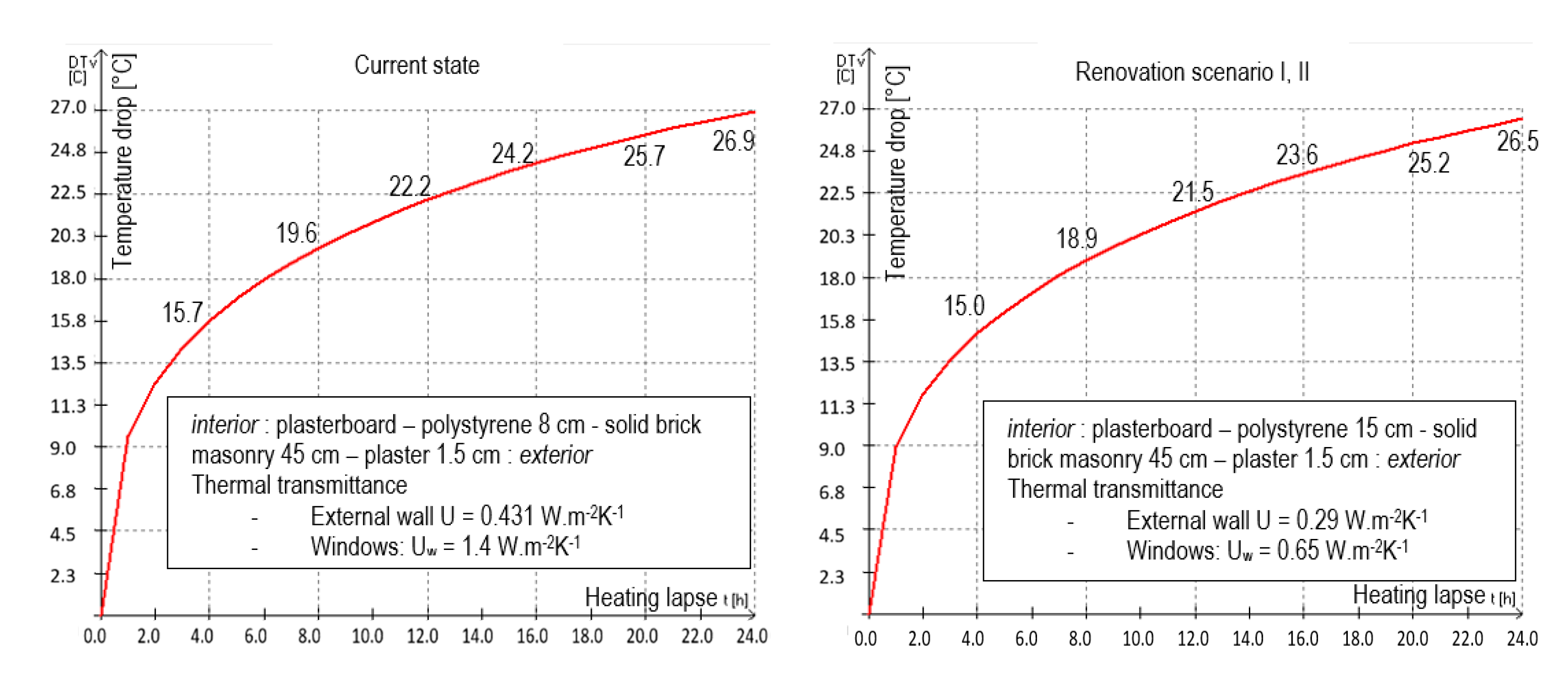

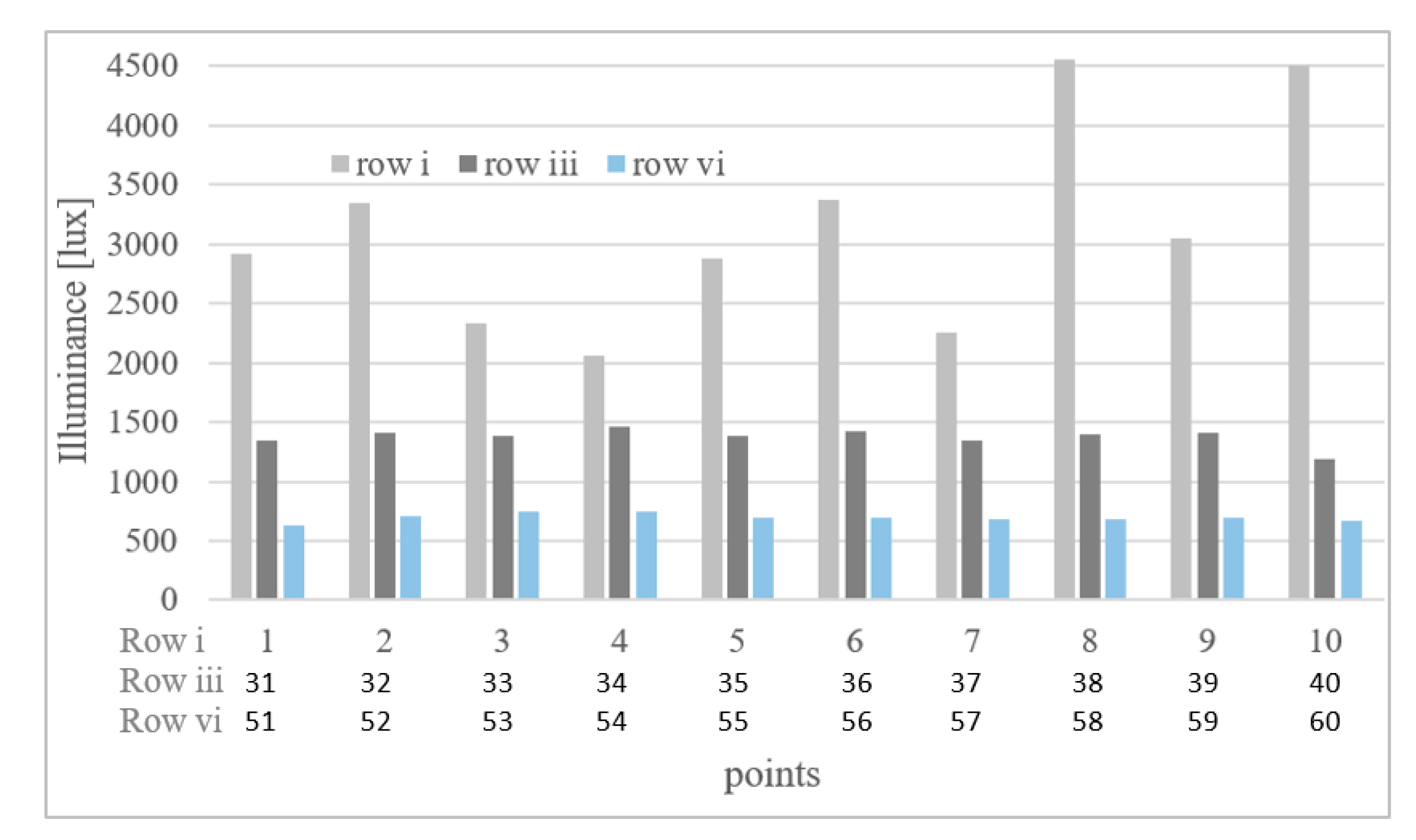

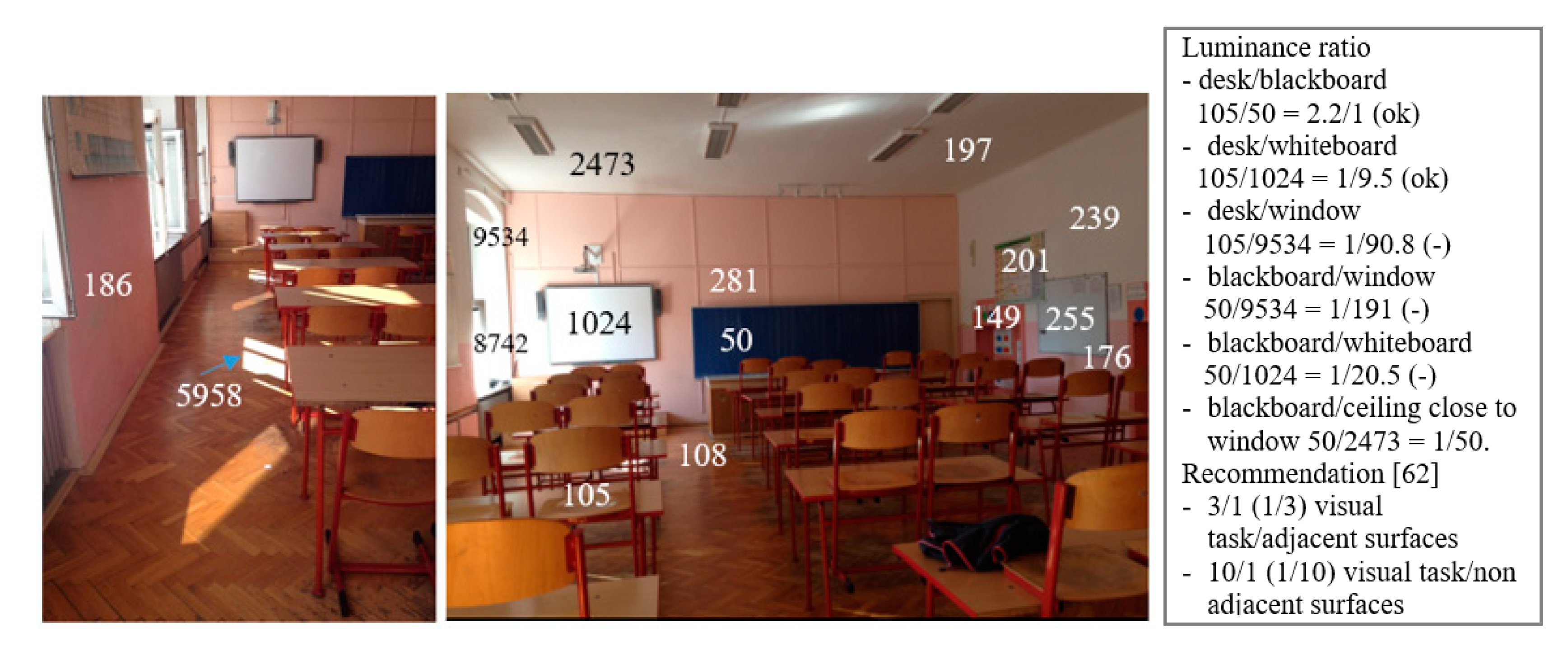

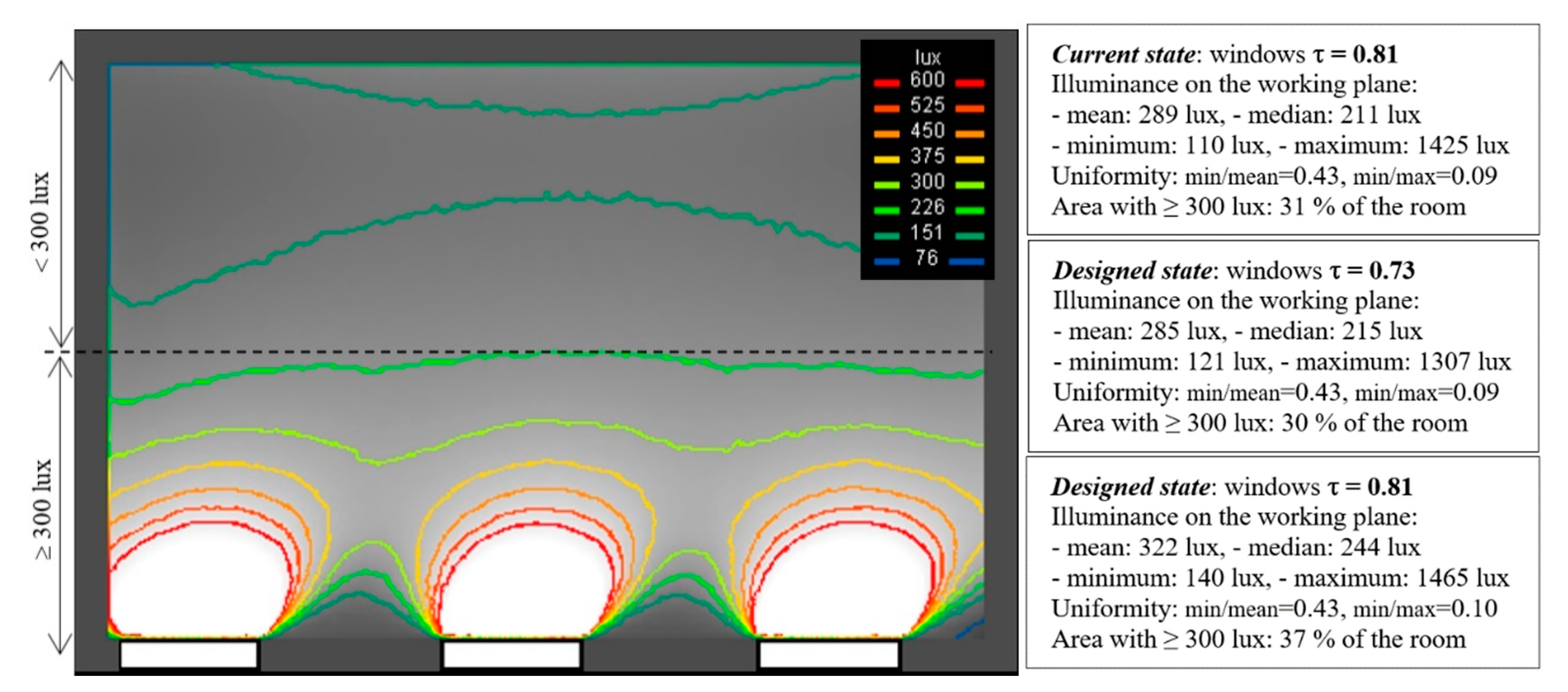
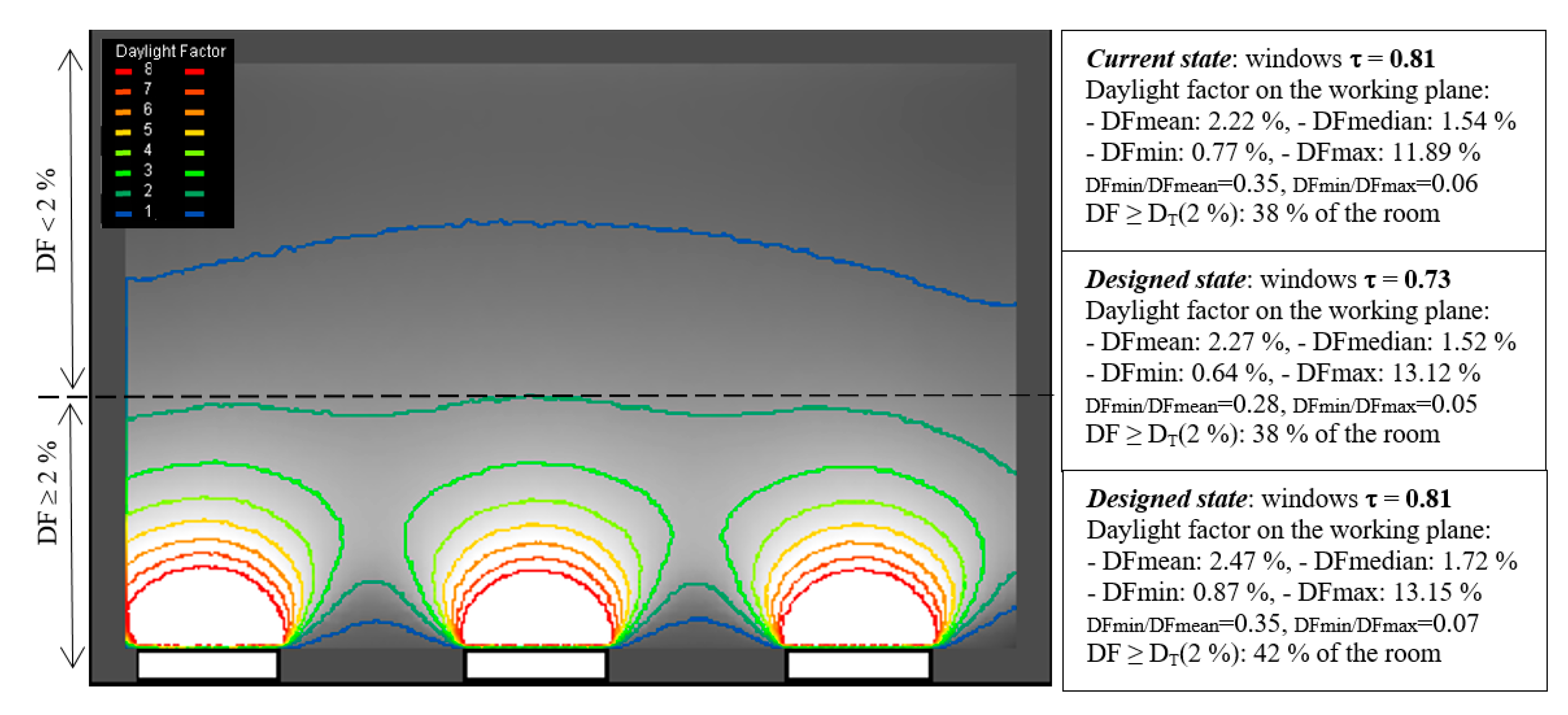
| Building | Year of Construction (Renovation) | Locality | Building Geometry | Building Envelope | ||||
|---|---|---|---|---|---|---|---|---|
| Altitude [m] | Latitude Longitude [°] | Aver. Winter Temperature [°C] | Building Volume [m3] | Gross Floor Area/Heated Volume [m−1] | Heat Loss [kW] | Average U Value [W m−2 K−1] | ||
| 1 | 1900 (2000) | 248 | 49.763969 N 17.180405 E | 4.1 | 3264 | 0.63 | 90 | 0.907 |
| 2 | 1950 | 210 | 49.456479 N 17.450230 E | 3.9 | 23,278 | 0.40 | 373.1 | 1.27 |
| 3 | 1994 | 272 | 49.038646 N 17.814872 E | 3.9 | 19,255 | 0.4 | 303.6 | 1.136 |
| 4 | 1931 | 272 | 49.038646 N 17.814872 E | 3.9 | 3448 | 0.47 | 61.1 | 0.954 |
| 5 | 1890 | 334 | 49.458565 N 18.056868 E | 3.8 | 1938 | 0.574 | 50.1 | 0.97 |
| 6 | 1984 | 304 | 49.6819311 N 18.3673219 E | 3.7 | 23,955 | 0.45 | 434 | 1.087 |
| 7 | 1949 | 336 | 49.712716 N 13.204605 E | 3.6 | 3491 | 0.43 | 88.7 | 1.23 |
| 8 | 1978 | 387 | 49.443259 N 13.248114 E | 3.7 | 1471 | 0.85 | 61.1 | 0.95 |
| 9 | 1937 | 520 | 49.7161561 N 13.9473069 E | 3.5 | 7163 | 0.47 | 102 | 0.90 |
| 10 | 1930 | 440 | 49.4248869 N 13.8817589 E | 3.7 | 11,427 | 0.503 | 276.5 | 1.05 |
| 11 | 1988 | 225 | 50.289161 N 14.824512 E | 3.8 | 5288 | 0.40 | 99.4 | 0.82 |
| 12 | 1960 | 188 | 48.9.07468 N 16.775371 E | 4.5 | 4140 | 0.48 | 82.6 | 1.18 |
| 13 | 1929 | 450 | 50.129276 N 16.499965 E | 3.6 | 6670 | 0.40 | 160.6 | 1.21 |
| 14 | 1967 | 179 | 49.059797 N 17.495850 E | 3.6 | 3326 | 0.46 | 78 | 1.33 |
| 15 | 1980 | 675 | 49.908449 N 17.211115 E | 3.1 | 4131 | 0.68 | 130 | 1.02 |
| 16 | 1887 (1962) | 378 | 49.303454 N 14.158029 E | 3.7 | 21,777 | 0.37 | 380.6 | 1.1 |
| 17 | 1980 | 334 | 49.820923 N 18.262524 E | 3.6 | 22,423 | 0.25 | 424.5 | 0.76 |
| 18 | 1894 (2014) | 280 | 50.655668 N, 14.724856 E | 2.9 | 17,244 | 0.24 | 396 | 0.72 |
| Current State | Renovated Scenario I, II | ||
|---|---|---|---|
| Total solar transmittance of window | g = 0.65 | Total solar transmittance of window | g = 0.53 |
| Solar gains | 2141.64 W | Solar gains | 1746.26 W |
| Heat gain through facade | 4857.30 W | Heat gain through façade | 3961.7 |
| Heat ventilation loss | Heat ventilation loss | ||
| (for ventilation rate 0.5 h−1) | −32.78 W | (for ventilation rate 0.5 h−1) | −32.78 W |
| Total heat gain | 6966.16 W | Total heat gain | 5675.24 W |
| Max. indoor temperature rise per day | 16.5 °C | Max. indoor temperature rise per day | 14.7 °C |
| Luminance [cd/m2] | Lhorizon | L15° | L45° | Lzenith | |
|---|---|---|---|---|---|
| time | Elevation Angle | 0° | 15° | 45° | 90° |
| 11:45 | direction 1 | 1923 | 890 | 8337 | 1716 |
| direction 2 | 961 | 4906 | 3393 | 1727 | |
| direction 3 | 1897 | 1634 | 1143 | 2065 | |
| direction 4 | 5437 | 2978 | 2148 | 1880 | |
| 12:50 | direction 1 | 4883 | 7204 | 1422 | 1514 |
| direction 2 | 1081 | 2066 | 1070 | 1333 | |
| direction 3 | 824 | 2309 | 1752 | 1244 | |
| direction 4 | 1187 | 257 | 811 | 1299 | |
© 2020 by the authors. Licensee MDPI, Basel, Switzerland. This article is an open access article distributed under the terms and conditions of the Creative Commons Attribution (CC BY) license (http://creativecommons.org/licenses/by/4.0/).
Share and Cite
Mohelníková, J.; Novotný, M.; Mocová, P. Evaluation of School Building Energy Performance and Classroom Indoor Environment. Energies 2020, 13, 2489. https://doi.org/10.3390/en13102489
Mohelníková J, Novotný M, Mocová P. Evaluation of School Building Energy Performance and Classroom Indoor Environment. Energies. 2020; 13(10):2489. https://doi.org/10.3390/en13102489
Chicago/Turabian StyleMohelníková, Jitka, Miloslav Novotný, and Pavla Mocová. 2020. "Evaluation of School Building Energy Performance and Classroom Indoor Environment" Energies 13, no. 10: 2489. https://doi.org/10.3390/en13102489





